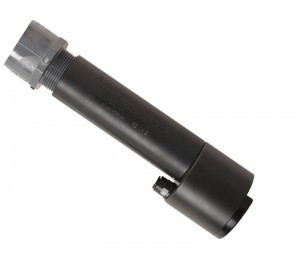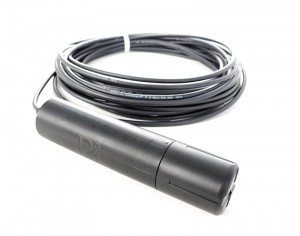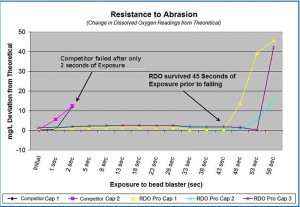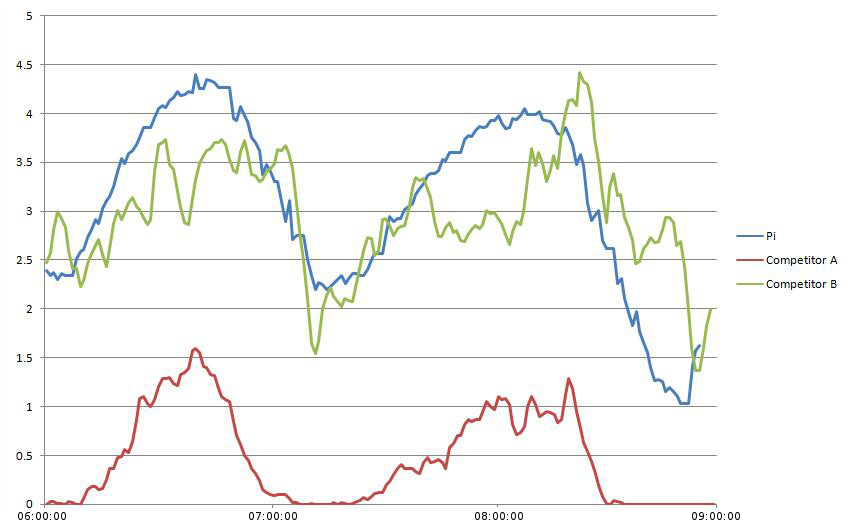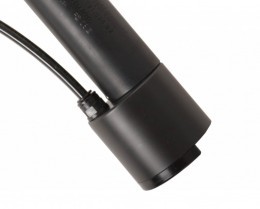The OxySense DO analyzer range of online DO analyzers utilizes the very latest and best optical sensor available in the world today. It is an optical luminescent device which is extremely resistant to abrasion, extremely stable, and has greatly reduced maintenance and whole life costs. Coupled with the automatic self cleaning and self verification, the OxySense online DO analyzer is as close to ‘fit and forget’ as it gets.
The OxySense Online Optical Dissolved Oxygen Analyzer with self-cleaning and self-verification offers enhanced reliability and unrivalled low maintenance. Optical DO meters have largely replaced electrochemical DO sensors (Clark Cells) due to their better reliability and lower maintenance requirements.
The OxySense DO sensor is available with different controllers giving you the same great performance with different communication, display, and control options.
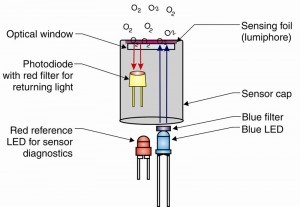
There is also a time delay between the peak emission of blue light and peak response of fluoresced red light. The amount of delay is inversely proportional to the amount of oxygen present. This time delay can be expressed as a phase shift between the wave patterns of incident blue light and the fluoresced red light. This is in turn reported by the electronics as a ppm or mg/l reading of Dissolved Oxygen. The advantages of this technology are that it is more stable than traditional electrochemical devices and far more resistant to abrasion. By using the state of the art sensor and electronics together the reliability, accuracy, and flexibility of the OxySense Online Optical DO analyzer is far superior to that of its competitors.
Suppliying The World’s Most Reliable Dissolved Oxygen Monitor
What is probably the world’s most reliable Dissolved Oxygen sensor from In-Situ® the RDO® sensor coupled with Pi’s award winning electronics provides up to 36 months between maintenance and calibration events and results in probably the best online DO analyzer available in the world today.
The self-verification option (patent pending) is revolutionizing calibration routines in that this Dissolved Oxygen analyser is able to check its own functionality on a regular basis and call for calibration when necessary.
- Down to zero maintenance
- No chemicals or moving parts
- Optional self-cleaning and self-verification system
- Stable and reliable – excellent process control
- Suitable for all Dissolved Oxygen applications
- Up to 36 months between maintenance
- No initial calibration required
- Rugged online optical DO analyzer
- Better performance than its competitors’ dissolved oxygen sensors
- Range of process control PID options – reduces labour costs
- Optional Autoflush Compressor
- Proven reliability
- Up to 36 months between calibration events
- Data-logging and remote internet access with text alarms
Get more info on the dissolved oxygen analyzer
Please contact us by using the form below.
The online measurement of Dissolved Oxygen in an aeration lane or an oxidation ditch is critical to the efficient running of the plant. With the electrical costs of aerating the waste water with blowers etc. often making up 50% of the total running costs of the plant, any drift or inaccuracy of the measurement can result in large sums wasted.
This reliance on online DO meters to control the blowers etc. means that they must be reliable, robust and free of drift; in an ideal world they would be free from maintenance, an ongoing, tedious, and expensive aspect of owning dissolved oxygen analyzers.
The general industry move away from amperometric Clark cells towards optical sensors has made a large improvement to monitoring DO in aeration lanes, but not all optical DO meters are the same. Many, even the industry leaders, drift over time and are subject to high levels of maintenance.
Pi has partnered with In-Situ®, the manufacturer of probably the world’s most reliable and robust online optical DO sensor and have created an instrument designed to give the industry as close to a zero maintenance instrument as possible.
- Lumiphore life of 3 years plus
- Inconsiderably low drift
- Autoclean – water or air
- Alarms for dirty sensor, lack of response, sensor failure etc.
- No initial calibration required
- Zero operator intervention for up to 3 years
In a trial in the UK, an instrument was installed on an aeration lane and required zero maintenance (including calibration) for over 12 months whilst maintaining its accuracy.
If you would like to run a trial in your plant or would like to learn more about the OxySense from Pi then why not contact us?
The OxySense DO Meter is able to reduce maintenance by automatically checking its sensor operation at user defined time intervals. Calibration on the In-Situ® sensor is normally required only once per annum so with the automatic sensor verification option and the self clean option the sensor can maintain its accuracy without any maintenance for up to three years.
The self cleaning and self verification system periodically blasts the end of the sensor with compressed air (supplied either from an on-site compressor or from Pi’s purpose built AirFlush compressor). This air firstly cleans the sensor but also acts to expose the sensing lumiphore to atmospheric O2 levels.
The response from the sensor to this air is checked by the system controller and if OK the system continues to operate as normal. If the sensor response is not as expected then an alarm is raised, alerting site staff to the problem. This system means routine sensor maintenance is no longer needed.
Any questions?
Please contact us by using the form below.
The AirFlush compressor is a custom made compressor that integrates perfectly with the OxySense system. With zero maintenance itself and self-error checking it is a trouble free option to reduce overall dissolved oxygen analyzer maintenance.
Any questions?
Please contact us by using the form below.
| Document | Type | Size |
|---|---|---|
OxySense |
Brochure | 736kB |
NIW DO Trial |
Article | 651kB |
Dissolved Oxygen Meter for Aeration Control |
Technical Note | 555kB |
AirFlush |
Technical Note | 592kB |
CRONOS® |
Brochure | 582kB |
CRIUS® |
Brochure | 584kB |
CRIUS® Remote Communications |
Brochure | 573kB |
CRONOS® and CRIUS® Control Options |
Technical Note | 534kB |
Remote Access GPRS |
Technical Note | 481kB |
Probe Fouling |
Technical Note | 382kB |
- is extremely resistant making it last longer in the harsh environment of an aeration lane.
- can self clean and self check its response every time it cleans.
Focus Ons are a series of short articles distributed by email providing technical information regarding instrumentation, process measurement in potable, waste, process and pool waters. If you would like to join the mailing list, please contact us.
… did you know that typically up to 50% of the cost of running a waste water treatment plant with aeration is the cost of the electricity to run the blowers?
… did you know that often the cost of purchasing many online DO meters is less than 10% of its 10 year total cost of ownership?
… did you know that an online DO meter that is reading 0.1 ppm low could cost more than its purchase and installation costs in increased electricity costs in just a few months?
Galvanic vs Optical DO measurements
Early measurement of online dissolved oxygen in waste water was made by electrochemical cells that needed sacrificial electrodes, electrolyte, membranes and a lot of calibration. Whilst there are some companies still advocating the use of this technology it was largely replaced in the 1990s and 2000s with online optical measurement. The vast majority of online DO systems used today are optically based. For a description of how they work click here.
Why is controlling the blowers so important?
Simply put, the microbes need enough oxygen to do the job. More oxygen than this and we are wasting energy and promoting the growth of unwanted biologies in the process. Many plants are estimated to waste significant energy by over aerating their process.
What do you need from an online DO meter?
Reliability, Dependability and Reproducibility are the three most important things that a plant needs if it is to optimize its treatment (i.e. control the DO in the aeration lanes to a precise and accurate level).
Typically an aeration basin will have ‘lanes’ with more then one DO sensor. If these DO meters are reading very different levels and do not track each other it is very difficult for a plant to know how to implement a control strategy. DO meters fail low, an unfortunate consequence of the technology. A reliable, dependable and reproducible DO meter will be consistent and will check it’s own responsiveness so an operator doesn’t need to worry.

Reliability means Robust
The Process Instruments In-Situ® sensor has what is probably the most robust lumiphore (sensing material) of any available DO meter. The lumiphore is the disc of material that is used to sense the amount of oxygen present and it needs to be tough to withstand the high energy, aggressive environment that they work in.
Below is a graph of how long the In-Situ® lumiphore works during a SANDBLASTING experiment against two other leading suppliers of online dissolved oxygen monitors. The results are staggering. The Pi/In-Situ® sensor lasts more then 20 times longer! You can’t scratch our lumiphore off with a thumbnail!
Dependability means Clean
If you ask operators how often they maintain a DO meter (clean/calibrate etc.) you often get the answer “every week”. On a large plant that can mean an operator spends half their time doing nothing but maintaining the DO sensors!
The Pi online DO analyzer has an optional cleaning system that can clean the lumiphore and keep it clean potentially for the entire life of the sensor. Utilizing compressed air from site or a small robust compressor available from Pi, the autoclean keeps the sensor clean and that’s not all…
Dependability means Self-Checking
If you ask the operator why they clean/calibrate the sensor weekly you will often get the answer “so we know it’s working”.
In modern plants the DO levels are kept low to reduce the energy required for the blowers. This means that the DO sensors can often read close to 0 mg/l.
How do we know that the sensors are reading correctly and aren’t faulty?
The traditional solution is for an operator to pull the sensor out and watch it respond to air, and when it’s out the operator may as well clean it and calibrate it.
What if there was a way to check the response to air without taking it out of the aeration lane?
Well there is! The Pi autoclean system not only automatically cleans the system but whilst doing so, also checks the response to air. Any issues are reported to the operator who no longer has to maintain the sensors every week. Click here for a video.
How long can they last without any operator interference?
On a recent trial in a UK Utility the Pi OxySense was installed for 13 months alongside their existing DO meter and during that time the sensor was removed once for manual cleaning when the power to the autoclean system was inadvertently off for a week. That was the only time the sensor was removed from its position in the aeration lane and throughout the entire trial the instrument was reliable, dependable, and consistently accurate.
Introduction
Northern Ireland Water (NIW) recently trialled three dissolved oxygen analyzers (DO meters) in parallel. These were installed at Culmor Waste Water Treatment Plant side by side in the same aeration lane, where measurements were recorded every minute for 6 months.
After processing more than a million points of data, the OxySense from Process Instruments (Pi) was shown by NIW to be the best solution.
The graph shows a three hour snapshot of some of the results that led to NIW deciding that Pi’s DO meter performed the best overall. From looking at this graph it is clear why Pi was preferred: Competitor A’s sensor displays a low, inaccurate reading and Competitor B’s sensor is afflicted by noise. These results are discussed in more details later in this Focus On.
The Plant
The trial plant had used Competitor B’s DO meters for some time in all their aeration lanes, however they found that the sensing end cap required replacing quite frequently (every 6 months). The replacement costs of £90 ($120, €105) per sensor started to accumulate and the plant decided to seek an alternative.
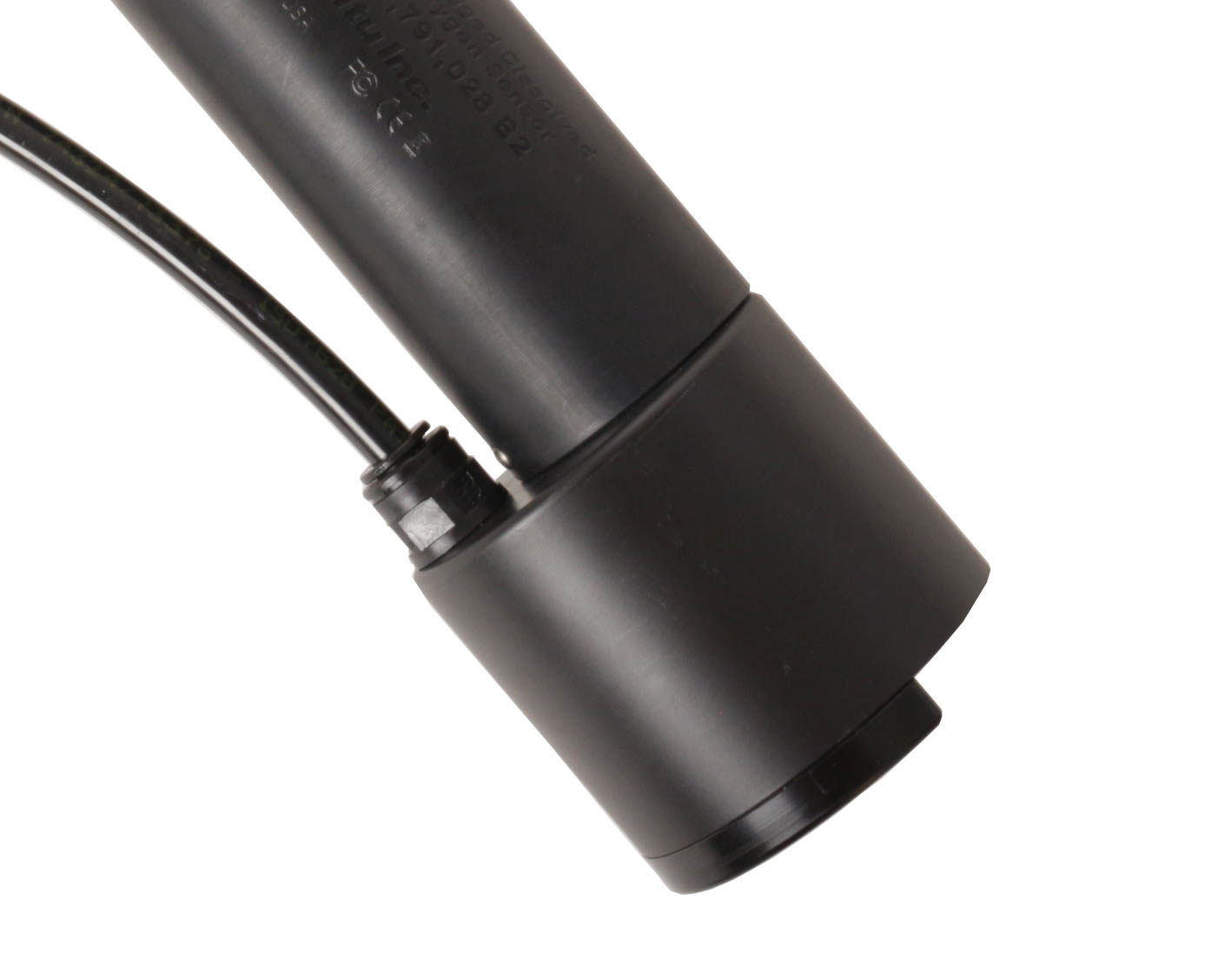 Auto-Cleaning
Auto-Cleaning
Pi’s sensor was equipped with its autoclean end cap (see image, right), which actively cleans the sensor with compressed air (or clean water) to remove sludge and debris from the sensor tip on a regular basis.
“When the probes were removed from the lane it was obvious that Pi’s cleaning system worked well and would massively reduce maintenance time and cost.”
Peter Martin, M&E Manager, NIW.
Competitor A’s sensor was attached to a flexible mounting which allowed the sensor to move with the sludge and aeration bubbles, theoretically cleaning the sensor passively.
Competitor B’s sensor did not have any automatic cleaning functionality.
All three sensors periodically received a manual clean as part of the plant’s regular maintenance schedule, ensuring the test was fair for the sensors without a cleaning system.
Measurements from the 25th of May 2015 have been used to demonstrate the variation between the different analyzers. This date set was chosen to be representative of the whole trial.
Process Instruments
The trial found that the CRIUS® OxySense from Pi provided the most accurate and reliable DO meter. The sensor was kept clean by Pi’s autoclean system, and reported accurate and precise readings with the lowest noise. A gradual increase in dissolved oxygen content is easily observed during aeration, followed by a steady decline as the air blowers are turned off.
Competitor A
Competitor A’s sensor struggled to keep itself clean between the regular maintenance events, as the passive self cleaning system was ineffective. The instrument appears to inaccurately report lower readings as a result of sludge and debris coating the sensor. The DO sensor detects the increased oxygen dissolved during aeration, but then falls to a reading of zero for long periods of time.
Competitor B
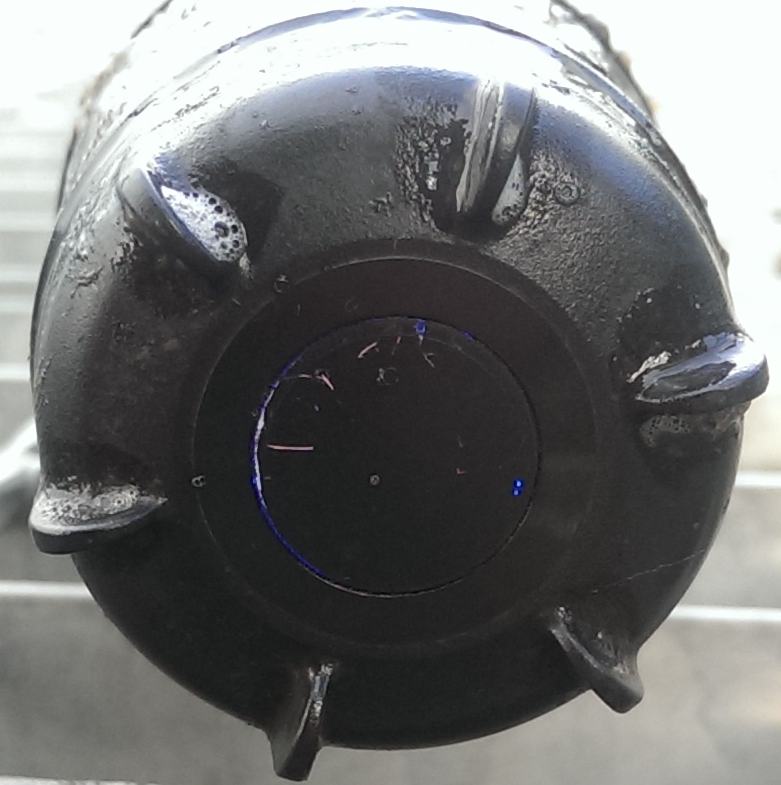 Readings from Competitor B’s sensor appear to lack precision and contain noise. This is most likely due to fouling of the sensor head (see image, right). The results had large variations between measurements, often making it difficult to distinguish the peaks during aeration. By the end of the six months, Competitor B’s sensor was found to be worn and required a replacement lumiphore end cap.
Readings from Competitor B’s sensor appear to lack precision and contain noise. This is most likely due to fouling of the sensor head (see image, right). The results had large variations between measurements, often making it difficult to distinguish the peaks during aeration. By the end of the six months, Competitor B’s sensor was found to be worn and required a replacement lumiphore end cap.
“It was clear that Pi’s sensor was more robust than the (Competitor B) sensor. After 6 months, I fully expect it to complete its minimum expected lifetime of 2 years.”
Peter Martin, M&E Manager, NIW.
Many different sites ranging across the whole water industry have a daily struggle to keep instrumentation functioning correctly due to fouling. However did you know that…
… self cleaning and self flushing systems are now available from Process Instruments for most types of sensors?
… these fouling removal systems can extend the life of sensors and drastically reduce maintenance regimes?
… Pi’s self cleaning/flushing systems are affordable, simple and trouble free by design?
Sensor Fouling – Why is it such a problem?
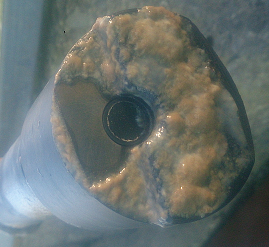 Whatever the process being monitored is, there is often something in the sample water capable of fouling a sensor, and therefore causing erroneous results. The obvious solution to this problem is to clean the sensor, but how regular should inspection and cleaning programs be for each piece of instrumentation? Too regular and the inspection and cleaning regime is time consuming and unnecessarily costly. Not often enough and the instrumentation will give false results and probably fail prematurely.
Whatever the process being monitored is, there is often something in the sample water capable of fouling a sensor, and therefore causing erroneous results. The obvious solution to this problem is to clean the sensor, but how regular should inspection and cleaning programs be for each piece of instrumentation? Too regular and the inspection and cleaning regime is time consuming and unnecessarily costly. Not often enough and the instrumentation will give false results and probably fail prematurely.
Solution: Pi’s Autoclean & Autoflush Systems
Simple, reliable and easy to maintain, Process Instruments’ Autoclean/Autoflush systems are an alternative to mechanical cleaning mechanisms which can clog and break. By regularly spraying the sensor/probe with clean water or air, the sensor remains clean and free from fouling for extended periods of time. The sensor cleaning cycle is activated by Pi’s controller for a user selectable length of time and frequency so that no matter how dirty the application, the probe remains clean. With no moving parts in the sensor body or in the cleaning attachment there is nothing to replace or check other than a simple valve positioned in an easy to reach location.
Pi’s Autoclean and Autoflush systems can give trouble free and fouling free functioning of sensors for weeks, if not months, at a time.
Autoclean
This option can be added to our pH, ORP, Turbidity, Suspended Solids and Dissolved Oxygen (DO) sensors. Consisting of an end cap to direct the flow of clean water (or air for a DO sensor) across the face of the sensor blasting any dirt away. The cleaning is controlled by a single valve positioned in an easily accessible location.
Autoverify
If using air to clean a DO sensor the system can also automatically verify that the sensor is still responding correctly, removing any need to remove the sensor from the sample for months at a time.
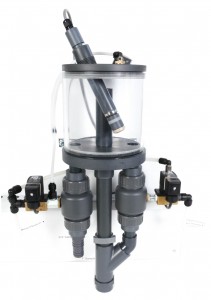
Autoflush
For sensors that require flow cell mounting like Chlorine, Ozone and Chlorine Dioxide, an Autoflush system has inbuilt valves which automatically start/stop the sample flow and control the flow of clean water past the probe. The user can set the flushing interval and duration to keep the flow cell and sensor clear from fouling. For particularly dirty or stubborn contaminants, warm water can be used as the flush water to aid cleaning.
With the above options, whatever the application or parameter being measured, Process Instruments will be able to provide a monitoring system that will not only be accurate, precise and long lasting but that will also remain free from fouling and save the operator both time and money.


































